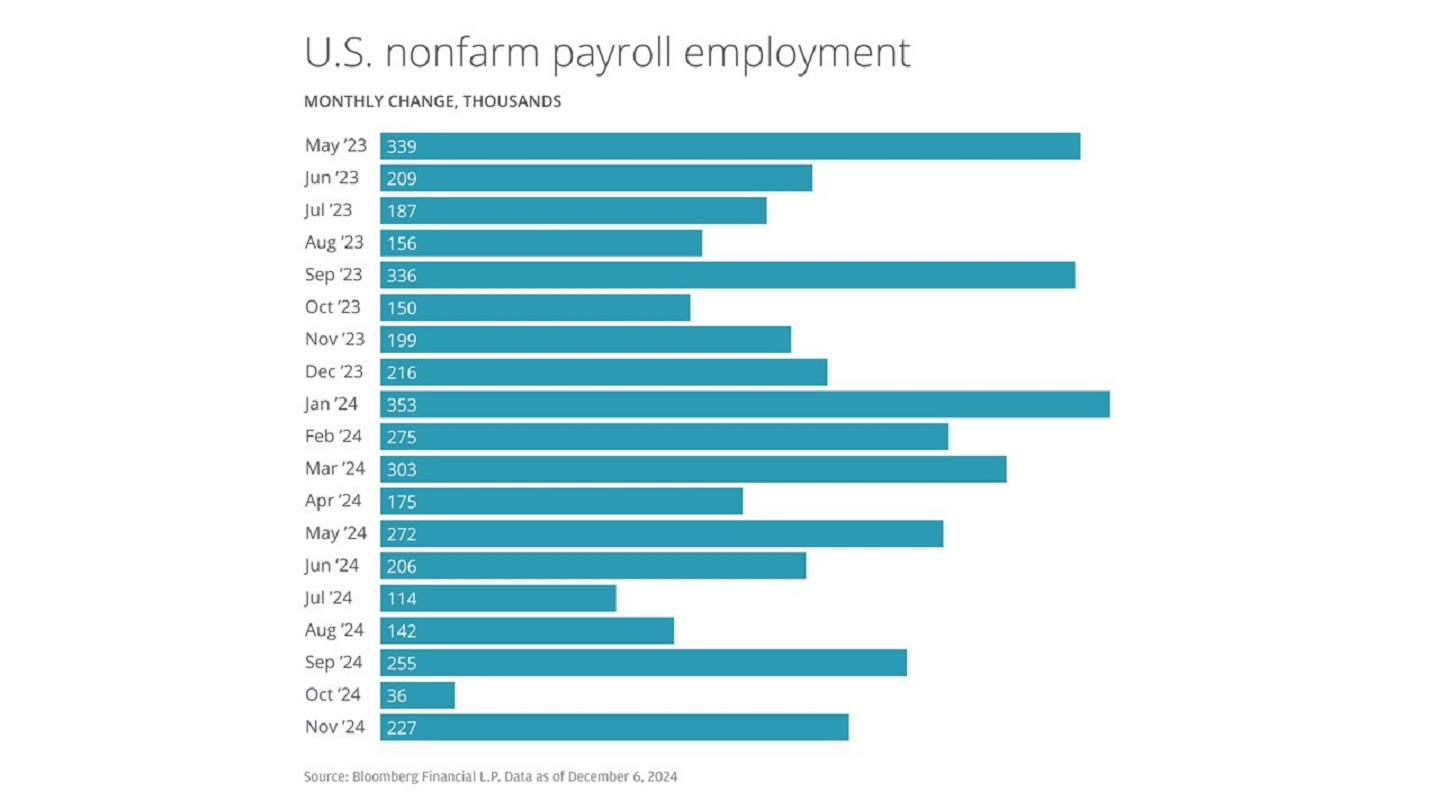
Key takeaways
- The U.S. economy added 227,000 jobs in November 2024, surpassing expectations and staging a robust rebound from the previous month. Notably, job gains for October were revised upward to 36,000 from 12,000, and September’s gains were adjusted to 255,000 from 223,000.
- While most indicators have returned to pre-pandemic levels (including the unemployment rate, which ticked up to 4.2%), wage growth remains an exception. Average hourly earnings increased by 4% year-over-year, which could support consumer purchasing power and confidence.
- Elyse Ausenbaugh, our Global Investment Strategist, believes this jobs report “bolsters our call on the Fed’s policy path from here – expect a gradual journey back to what the Fed describes as a ‘more neutral level.’ A cut in December looks likely, followed by four cuts in 2025 at an every-other-meeting cadence.”
- With a more balanced macroeconomic backdrop, Elyse emphasizes the importance for investors “to simultaneously focus on continuing to capture opportunity amid the soft landing while right-sizing allocations with a mindfulness on renewing portfolio resilience.”
Contributors

Associate, Wealth Planning & Advice
The U.S. economy added 227,000 jobs in November 2024, surpassing expectations and staging a robust rebound from the previous month. Notably, job gains for the prior two months were revised upwards by a total of 56,000, bringing the three month average payroll growth to 173,000. Additionally, job gains for October were revised upward to 36,000 from 12,000, and September’s gains were adjusted to 255,000 from 223,000.1
The rebound in the November jobs data is largely attributed to a recovery from disruptions in October, when job growth was weakened by hurricanes in the Southeast and a dockworkers’ strike.2
Our key takeaways from the November employment report are that the labor market remains firm and the economy is well balanced. As our Head of Investment Strategy Elyse Ausenbaugh observed, “COVID-era distortions seem to be fading away with metrics like job gains and the unemployment rates back to their pre-pandemic averages.”

Industry breakdown
In November, growth in nonfarm payrolls was primarily fueled by increases in several sectors. The healthcare sector added 54,000 jobs, while the leisure and hospitality sector added 53,000 jobs. Government employment rose by 33,000, and transportation equipment manufacturing employment rose by 32,000, indicating that dockworkers are returning to work following their strike. Additionally, the social assistance sector contributed with an increase of 19,000 jobs.3
Conversely, the retail trade sector saw a loss of 28,000 jobs. This drop followed little change the month prior and was primarily due to a sharp decrease in general merchandise retailers employment.4 This decline might reflect the later-than-usual Thanksgiving date, which possibly delayed hiring for the holiday season.
Meanwhile, employment levels remained relatively stable in other industries, such as mining, oil and gas extraction, and construction.5
Unemployment inched higher
In November, the unemployment rate ticked up slightly to 4.2% from 4.1% in October, remaining higher than the 3.7% rate in November 2023. The total number of unemployed individuals remained little changed at 7.1 million, still above the 6.3 number of unemployed individuals a year earlier.6
There was little change in the number of people who were not and are currently not actively looking for a job, discouraged workers or long-term unemployed workers. In contrast, the measure that includes both workers with part-time jobs for economic reasons and discouraged workers slightly increased to 7.8%.7
The labor force participation rate, which indicates the percentage of working-age individuals who are employed or actively seeking work, fell slightly to 62.5%.8
Wage growth remains sticky
While most indicators have returned to pre-pandemic levels, wage growth remains an exception. Average hourly earnings increased by a stronger 0.4% month-over-month and 4% year-over-year,9 but a broader set of wage indicators, such as job openings, continue to show slow normalization over time.
Ausenbaugh emphasized two things: “First, that the gains could continue to help consumer wallets and confidence adapt to the higher price levels brought on by recent years’ inflation pressures. Second, that it doesn’t need to shift the Federal Reserve’s (Fed) focus on recalibrating their policy stance.”
What could this mean for the Federal Reserve?
Ausenbaugh believes this jobs report “bolsters our call on the Fed’s policy path from here – expect a gradual journey back to what the Fed describes as a ‘more neutral level.’ A cut in December looks likely, followed by four cuts in 2025 at an every-other-meeting cadence.”
This jobs report follows the November Federal Open Market Committee meeting, in which the Federal Reserve (Fed) lowered interest rates by 25 basis points to bolster economic growth.10 Fed Chair Jerome Powell described the risks to the Fed’s dual mandate (maximum employment and stable prices) as “roughly in balance,” which should allow the economy to remain strong as the Fed lowers rates.
We expect the Fed to carefully assess upcoming data prints before its December 17 – 18 meeting. The November Consumer Price Index report, set to be released on December 11, will likely play an important role in the Fed’s decision-making as well.
What could this mean for investors?
With a more balanced macroeconomic backdrop, Elyse emphasizes the importance for investors “to simultaneously focus on continuing to capture opportunity amid the soft landing while right-sizing allocations with a mindfulness on renewing portfolio resilience.”
Connect with a Wealth Advisor
Reach out to your Wealth Advisor to discuss any considerations for your current portfolio. If you don’t have a Wealth Advisor, click here to tell us about your needs and we’ll reach out to you.
IMPORTANT INFORMATION
This material is for informational purposes only, and may inform you of certain products and services offered by J.P. Morgan’s wealth management businesses, part of JPMorgan Chase & Co. (“JPM”). Products and services described, as well as associated fees, charges and interest rates, are subject to change in accordance with the applicable account agreements and may differ among geographic locations. Not all products and services are offered at all locations. If you are a person with a disability and need additional support accessing this material, please contact your J.P. Morgan team or email us at accessibility.support@jpmorgan.com for assistance. Please read all Important Information.
GENERAL RISKS & CONSIDERATIONS. Any views, strategies or products discussed in this material may not be appropriate for all individuals and are subject to risks. Investors may get back less than they invested, and past performance is not a reliable indicator of future results. Asset allocation/diversification does not guarantee a profit or protect against loss. Nothing in this material should be relied upon in isolation for the purpose of making an investment decision. You are urged to consider carefully whether the services, products, asset classes (e.g. equities, fixed income, alternative investments, commodities, etc.) or strategies discussed are suitable to your needs. You must also consider the objectives, risks, charges, and expenses associated with an investment service, product or strategy prior to making an investment decision. For this and more complete information, including discussion of your goals/situation, contact your J.P. Morgan representative.
NON-RELIANCE. Certain information contained in this material is believed to be reliable; however, JPM does not represent or warrant its accuracy, reliability or completeness, or accept any liability for any loss or damage (whether direct or indirect) arising out of the use of all or any part of this material. No representation or warranty should be made with regard to any computations, graphs, tables, diagrams or commentary in this material, which are provided for illustration/reference purposes only. The views, opinions, estimates and strategies expressed in this material constitute our judgment based on current market conditions and are subject to change without notice. JPM assumes no duty to update any information in this material in the event that such information changes. Views, opinions, estimates and strategies expressed herein may differ from those expressed by other areas of JPM, views expressed for other purposes or in other contexts, and this material should not be regarded as a research report. Any projected results and risks are based solely on hypothetical examples cited, and actual results and risks will vary depending on specific circumstances. Forward-looking statements should not be considered as guarantees or predictions of future events.
Nothing in this document shall be construed as giving rise to any duty of care owed to, or advisory relationship with, you or any third party. Nothing in this document shall be regarded as an offer, solicitation, recommendation or advice (whether financial, accounting, legal, tax or other) given by J.P. Morgan and/or its officers or employees, irrespective of whether or not such communication was given at your request. J.P. Morgan and its affiliates and employees do not provide tax, legal or accounting advice. You should consult your own tax, legal and accounting advisors before engaging in any financial transactions.
Legal Entity and Regulatory Information.
J.P. Morgan Wealth Management is a business of JPMorgan Chase & Co., which offers investment products and services through J.P. Morgan Securities LLC (JPMS), a registered broker-dealer and investment adviser, member FINRA and SIPC. Insurance products are made available through Chase Insurance Agency, Inc. (CIA), a licensed insurance agency, doing business as Chase Insurance Agency Services, Inc. in Florida. Certain custody and other services are provided by JPMorgan Chase Bank, N.A. (JPMCB). JPMS, CIA and JPMCB are affiliated companies under the common control of JPMorgan Chase & Co. Products not available in all states.
Bank deposit accounts and related services, such as checking, savings and bank lending, are offered by JPMorgan Chase Bank, N.A. Member FDIC.
This document may provide information about the brokerage and investment advisory services provided by J.P. Morgan Securities LLC (“JPMS”). The agreements entered into with JPMS, and corresponding disclosures provided with respect to the different products and services provided by JPMS (including our Form ADV disclosure brochure, if and when applicable), contain important information about the capacity in which we will be acting. You should read them all carefully. We encourage clients to speak to their JPMS representative regarding the nature of the products and services and to ask any questions they may have about the difference between brokerage and investment advisory services, including the obligation to disclose conflicts of interests and to act in the best interests of our clients.
J.P. Morgan may hold a position for itself or our other clients which may not be consistent with the information, opinions, estimates, investment strategies or views expressed in this document. JPMorgan Chase & Co. or its affiliates may hold a position or act as market maker in the financial instruments of any issuer discussed herein or act as an underwriter, placement agent, advisor or lender to such issuer.
